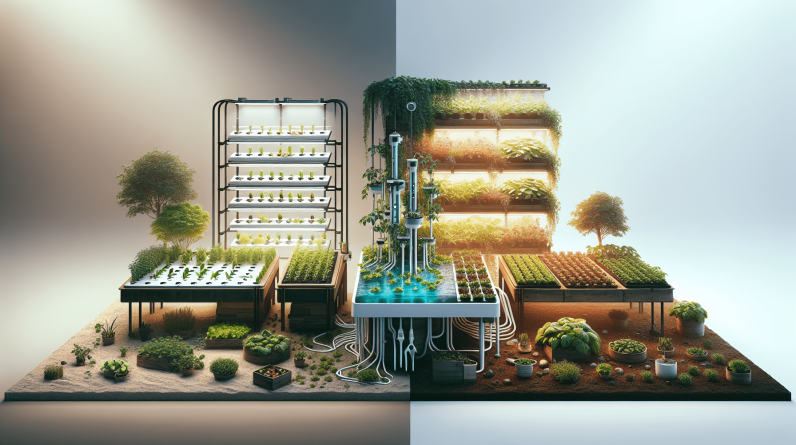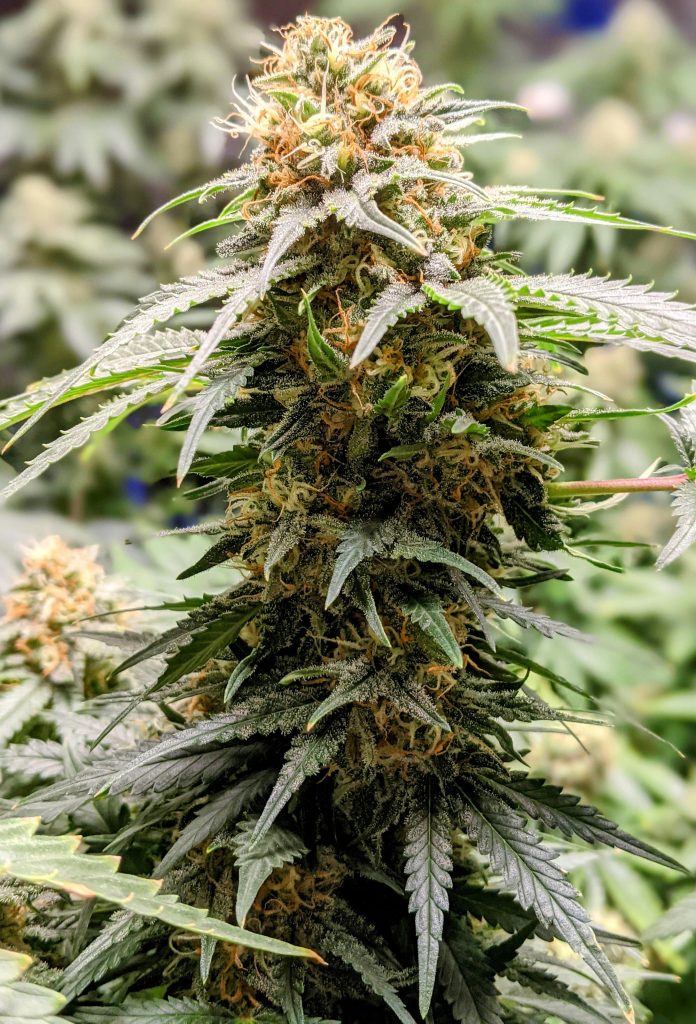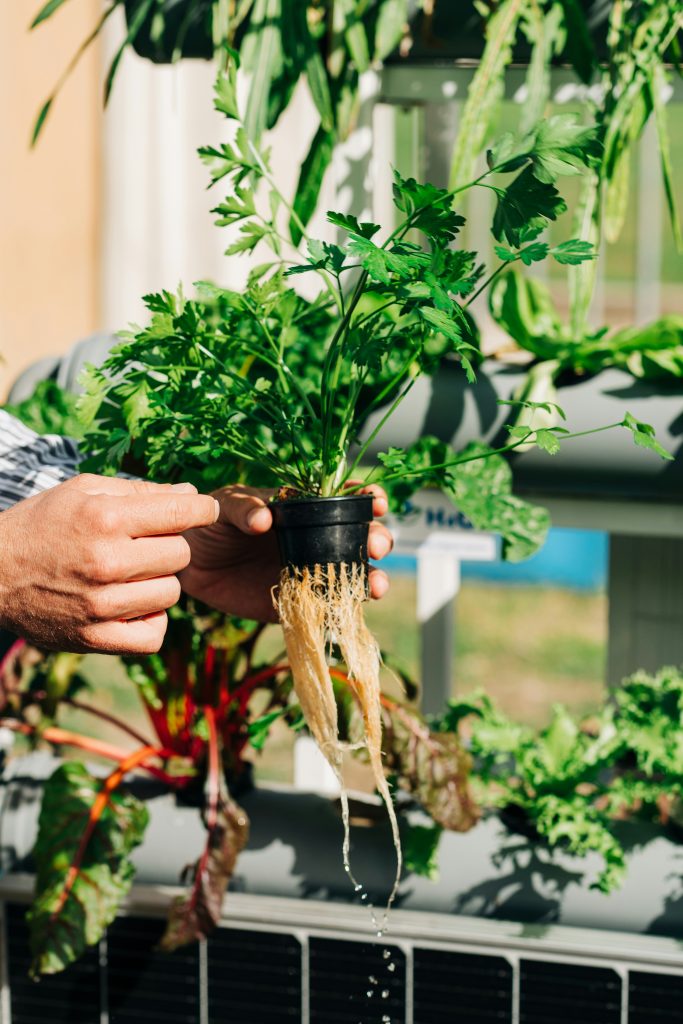
If you’re looking to maximize your gardening efforts, consider the comparison between hydroponic systems and traditional gardening. Hydroponic systems offer a range of benefits, such as faster plant growth, increased yield, water conservation, year-round cultivation, and reduced risks of pests and diseases. With the ability to produce healthy crops efficiently and sustainably, hydroponics is a modern gardening method worth exploring for your gardening needs. Have you ever wondered about the differences between hydroponic systems and traditional gardening? With so many options available for growing plants, it can be challenging to decide which method is best for you. In this article, we will explore the differences between hydroponic systems and traditional gardening to help you make an informed decision about how to grow your garden.

Benefits of Hydroponic Systems
Hydroponic growing systems offer numerous benefits that make them an attractive option for both beginners and experienced gardeners. These systems provide plants with a nutrient-rich solution directly to their roots, allowing them to grow faster and yield more produce. By eliminating the need for soil, hydroponic systems also conserve water, using up to 90% less than traditional soil gardening methods.
Hydroponic systems also enable year-round cultivation, regardless of external weather conditions. This means you can grow fresh produce throughout the year, even in colder climates where traditional gardening may not be possible. Additionally, hydroponic systems reduce the risk of soil-borne diseases and pests, resulting in healthier plants and fewer chemical inputs. Overall, hydroponics provides a sustainable and efficient approach to growing fresh, nutritious crops.
Faster Growth and Higher Yields
One of the key advantages of hydroponic systems is their ability to promote faster plant growth and higher yields. By providing plants with a constant supply of nutrients directly to their roots, hydroponic systems allow them to grow more quickly and efficiently. This results in larger, healthier plants that produce more fruits and vegetables than traditional gardening methods.
Water Conservation
Hydroponic systems are incredibly water-efficient, using up to 90% less water than traditional soil gardening. This is because the nutrient-rich solution used in hydroponics is recirculated and reused, minimizing water waste. In traditional gardening, water can be lost through evaporation and runoff, leading to higher water consumption overall. By conserving water, hydroponic systems help reduce environmental impact and promote sustainable growing practices.
Year-Round Cultivation
Another significant advantage of hydroponic systems is their ability to enable year-round cultivation. Unlike traditional gardening, which is often limited by external weather conditions, hydroponic systems can be used indoors or in controlled environments to grow plants throughout the year. This means you can enjoy fresh, homegrown produce regardless of the season, making hydroponics a versatile and convenient option for gardeners.
Reduced Risk of Diseases and Pests
Due to the absence of soil in hydroponic systems, plants are less susceptible to soil-borne diseases and pests. In traditional gardening, plants can be affected by a variety of diseases that are present in the soil, leading to stunted growth and reduced yields. By eliminating the need for soil, hydroponic systems reduce the risk of these issues, resulting in healthier plants that require fewer chemical inputs to maintain.
Advantages of Traditional Gardening
While hydroponic systems offer many benefits, traditional gardening also has its advantages that make it a popular choice among gardeners. Traditional gardening methods are familiar and accessible to most people, requiring only basic gardening tools and techniques. Gardeners can work directly with soil, planting seeds and transplanting seedlings into the ground, which can be a rewarding and therapeutic experience.
Familiarity and Accessibility
One of the primary advantages of traditional gardening is its familiarity and accessibility. Most people are familiar with traditional gardening methods, such as planting seeds in the ground and tending to plants as they grow. Traditional gardening is a hands-on experience that allows gardeners to work directly with soil, learning about the natural processes involved in plant growth and development. Additionally, traditional gardening is accessible to people of all skill levels, making it a popular choice for beginners and experienced gardeners alike.
Cost-Effectiveness
Traditional gardening can also be more cost-effective than hydroponic systems, as it requires fewer specialized equipment and materials. With traditional gardening, all you need are basic gardening tools, seeds, soil, and water to get started. This can make traditional gardening a more affordable option for those on a budget or looking to minimize expenses. Additionally, traditional gardening allows gardeners to save seeds from year to year, reducing the need to purchase new seeds annually.
Soil Health and Nutrient Diversity
Another advantage of traditional gardening is its focus on soil health and nutrient diversity. Soil contains essential nutrients that plants need to grow, including nitrogen, phosphorus, and potassium. Traditional gardening methods promote healthy soil by incorporating organic matter, such as compost and mulch, to improve soil structure and fertility. Additionally, traditional gardening allows for a diverse range of plants to be grown together, promoting biodiversity and beneficial interactions between different species.
Connection to Nature
Traditional gardening offers a unique connection to nature that is often lacking in hydroponic systems. Working with soil, plants, and the natural environment can be a grounding and meditative experience, allowing gardeners to connect with the natural world on a deeper level. Traditional gardening encourages mindfulness and presence, as gardeners observe the growth and development of plants over time, fostering a greater appreciation for the beauty and complexity of nature.

Comparison of Hydroponic Systems and Traditional Gardening
When choosing between hydroponic systems and traditional gardening, it’s essential to consider the specific needs and preferences of your plants, as well as your own gardening experience and goals. Both methods have their advantages and disadvantages, and the best choice for you will depend on factors such as space, resources, time, and personal preferences.
Space and Location
One of the key differences between hydroponic systems and traditional gardening is the space and location required to grow plants. Hydroponic systems can be set up indoors or in controlled environments, making them ideal for areas with limited outdoor space or unfavorable weather conditions. Traditional gardening, on the other hand, requires access to outdoor soil and sunlight, which may be challenging for urban or apartment dwellers.
Resource Efficiency
Hydroponic systems are incredibly resource-efficient, using less water and nutrients than traditional gardening methods. The nutrient-rich solution used in hydroponics is recirculated and reused, minimizing waste and promoting sustainability. Traditional gardening, on the other hand, may require more water and fertilizer to maintain healthy soil and plants, especially in arid or nutrient-poor environments.
Maintenance and Upkeep
Hydroponic systems require regular monitoring and maintenance to ensure optimal plant growth and health. This includes checking nutrient levels, pH balances, and water quality, as well as cleaning and maintaining equipment. Traditional gardening also requires maintenance, such as weeding, watering, and fertilizing, but may be less intensive than hydroponics in some cases. Consider your schedule and availability when choosing between hydroponic systems and traditional gardening.
Plant Growth and Yield
Both hydroponic systems and traditional gardening can produce healthy plants and high yields, but the methods differ in how they achieve these results. Hydroponic systems promote faster plant growth and higher yields by providing plants with a constant supply of nutrients directly to their roots. Traditional gardening relies on healthy soil and natural processes to support plant growth, which may result in slower growth and lower yields in some cases. Consider the specific needs of your plants and the desired outcome when deciding which method to use.

Conclusion
In conclusion, both hydroponic systems and traditional gardening offer unique advantages and benefits that make them suitable for different gardening needs and preferences. Hydroponic systems provide faster plant growth, higher yields, water conservation, reduced risk of diseases and pests, and year-round cultivation, making them an excellent choice for modern gardeners. Traditional gardening, on the other hand, offers familiarity, accessibility, cost-effectiveness, soil health, nutrient diversity, and a connection to nature that can be rewarding and fulfilling for gardeners of all skill levels.
When deciding between hydroponic systems and traditional gardening, consider factors such as space, location, resource efficiency, maintenance, plant growth, and yield to determine the best method for your gardening needs. Whether you choose to grow your plants hydroponically or in traditional soil, both methods can provide a rewarding and enjoyable gardening experience that allows you to connect with nature, nurture plants, and enjoy the fruits of your labor. Happy gardening!










